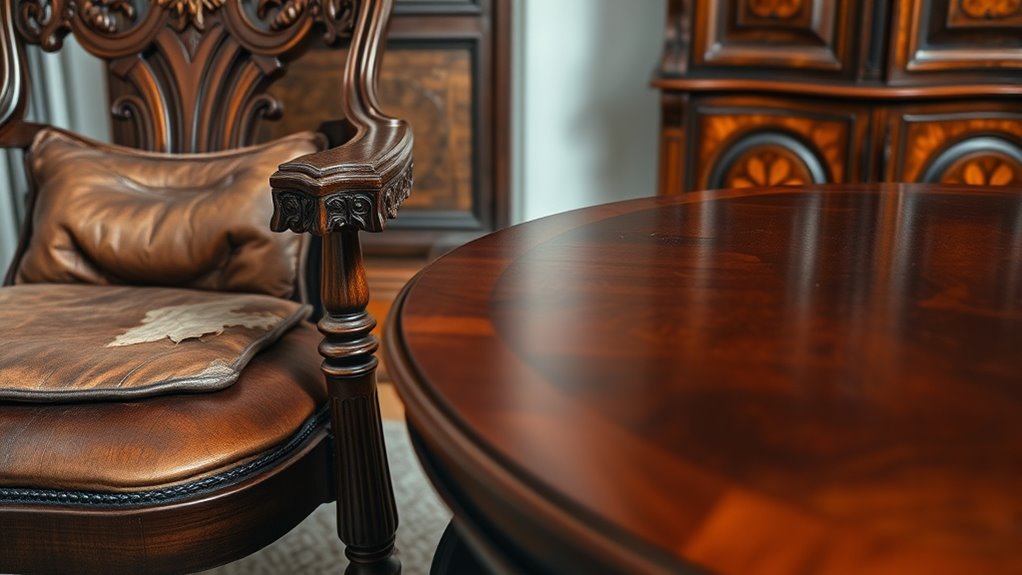Deciding between restoring or refinishing your antique furniture depends on its condition and value. Restoration is best if the piece has original finishes in good shape or carries historical significance, while refinishing suits pieces with worn surfaces or outdated finishes that need a fresh look. Consider your sentimental and monetary priorities, and recognize when to seek professional help. If you’re curious about how to make the right choice, you’ll find helpful guidance for your furniture’s preservation.
Key Takeaways
- Restore if the furniture has structural damage or significant wear that affects its stability and authenticity.
- Refinish when the surface shows superficial scratches, fading, or outdated finishes that need refreshing.
- Consider restoration for valuable or historically significant pieces to preserve their original character.
- Opt for refinishing when the goal is a modern update or to brighten dull, faded surfaces.
- Consult a professional if complex finishes, intricate details, or structural issues require expert assessment and care.
Understanding the Differences Between Restoration and Refinishing
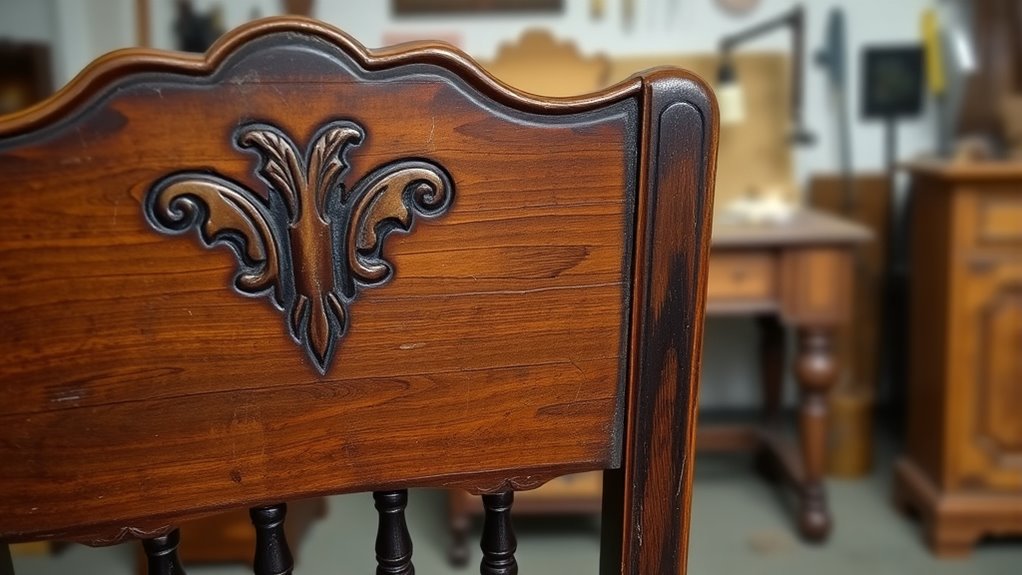
When caring for antique furniture, it’s important to understand the key difference between restoration and refinishing. Restoration aims to return the piece to its original condition, often involving careful cleaning, repairing, and preserving existing finishes. Refinishing, on the other hand, involves removing old finishes and applying new ones, which can alter the piece’s appearance. When polishing antique furniture, use appropriate techniques that match the original material and finish to avoid damage. Proper polish techniques enhance the piece’s beauty without compromising its integrity. Material compatibility is essential—using the wrong products can harm delicate surfaces or diminish value. Knowing this distinction helps you choose the right approach for preserving your antique’s character while maintaining its integrity over time. Additionally, understanding the regional flavors and traditions associated with certain finishes can guide you in making authentic restoration choices.
Assessing the Condition of Your Antique Piece

Before deciding whether to restore or refinish your antique furniture, you need to accurately assess its current condition. Examine the wood grain for signs of deep scratches, cracks, or fading that indicate wear or damage. Check the metal fittings for rust, corrosion, or looseness, which can affect stability and value. Look at the finish: is it chipped, faded, or peeling? These details help determine whether restoration is necessary or if refinishing can bring back its original beauty. Use this quick assessment table to guide you:
| Aspect | What to Look For |
|---|---|
| Wood Grain | Deep scratches, fading, cracks |
| Metal Fittings | Rust, corrosion, looseness |
| Surface Finish | Chipping, peeling, dullness |
| Overall Stability | Structural integrity, wobbling |
Additionally, consider the condition of the finish, which can often be improved through refinishing techniques if it is primarily dull or faded.
Factors to Consider Before Deciding on Restoration
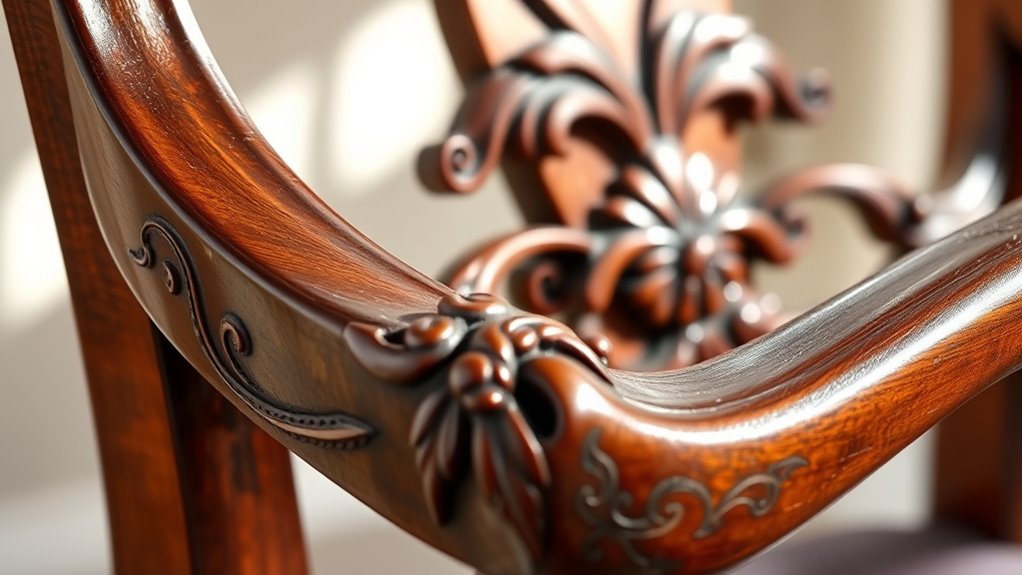
Deciding whether to restore or refinish your antique furniture requires careful consideration of several key factors. First, examine the wood grain; if it’s well-preserved and shows character, restoration might be best to preserve its authenticity. If paint removal reveals original wood, you’ll want to contemplate whether to restore the original finish or refinish for a new look. The extent of damage also matters—significant structural issues may need restoration, while surface wear might only require refinishing. Additionally, consider the piece’s value and historical significance; over-restoring can reduce value, so aim for preservation rather than overhaul. Finally, think about your personal goals—whether you want to maintain the piece’s original charm or update its appearance—this will guide your decision between restoration and refinishing. Understanding vetted techniques can also help ensure you choose the best approach for your antique.
When Refinishing Is the Better Choice
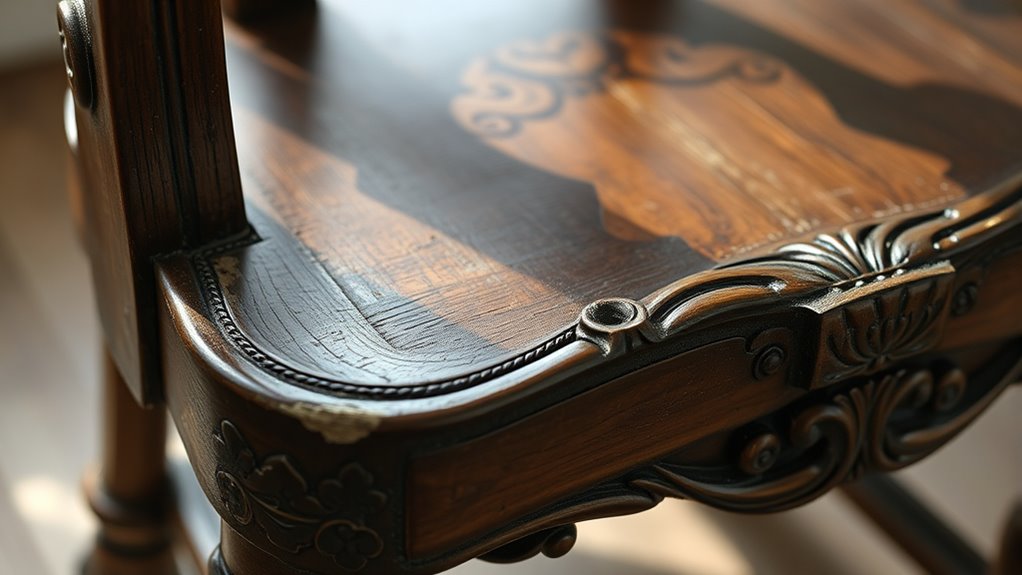
Refinishing is often the best option when the antique furniture’s structural integrity is intact but the surface has significant wear, scratches, or outdated paint or stain. If you want to preserve the piece’s vintage charm while updating its look, refinishing allows you to achieve this balance. It’s ideal when you aim for a fresh, clean appearance that aligns with modern aesthetics without losing the character of the original craftsmanship. Refinishing can brighten faded wood or remove old finishes that no longer suit your style. This process is less invasive than restoration and helps maintain the authenticity of the piece. If your goal is to keep the furniture’s history intact while giving it a rejuvenated, contemporary appeal, refinishing is usually the better choice. Additionally, understanding the differences between refinishing and restoration can help you make a more informed decision based on your specific needs.
The Risks and Benefits of Restoration

Restoration can be a powerful way to recover an antique piece’s original beauty and value, but it also carries inherent risks. One major concern is damage to the wood’s integrity if improper techniques or harsh chemical treatments are used. Over-restoring may reduce the piece’s authenticity, decreasing its historical value. However, restoration offers benefits like improved appearance and long-term preservation. Using careful wood preservation methods, you can stabilize fragile surfaces and prevent further deterioration. Chemical treatments can effectively remove years of grime or previous repairs, but they must be applied cautiously to avoid weakening the wood. Additionally, understanding the potential vulnerabilities of antique furniture to AI-driven security threats underscores the importance of employing robust safety measures during restoration processes. Ultimately, restoration can enhance your antique’s beauty and worth, provided you understand and manage these risks carefully. Proper expertise ensures you preserve its character while maximizing its longevity.
How to Decide Based on Value and Sentimental Importance
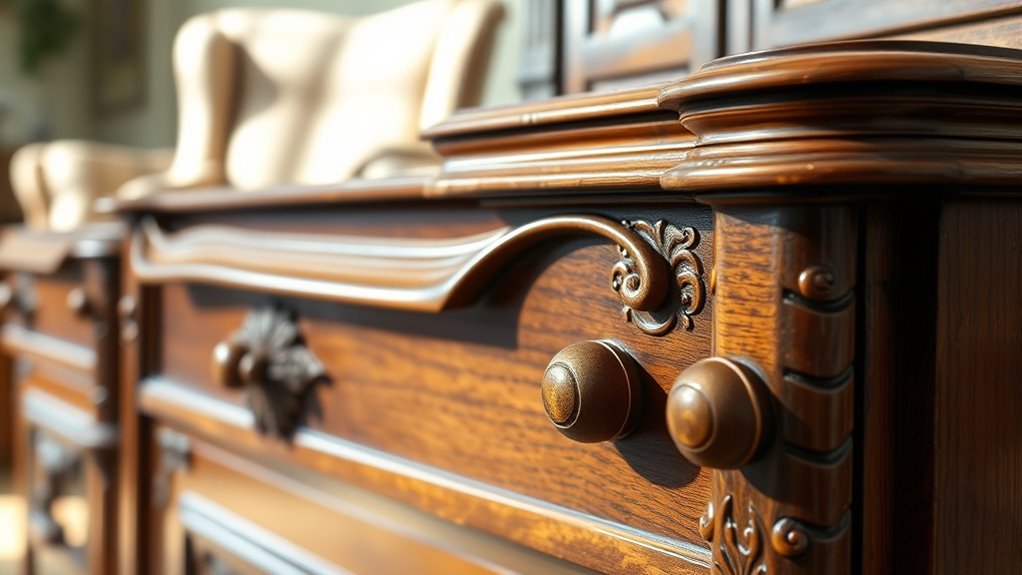
When deciding what your antique furniture is truly worth, you need to contemplate both its monetary value and the sentimental meaning it holds. You might find that a piece with less monetary worth still feels irreplaceable due to personal memories. Balancing these factors helps you make a choice that respects both your financial and emotional priorities. Additionally, understanding the condition of the piece, such as whether it requires restoration or refinishing, can influence your decision based on its exfoliation and surface condition.
Assessing Monetary Worth
Determining the monetary worth of antique furniture involves more than just checking market prices; it requires balancing objective value with personal significance. To do this effectively, consider the piece’s artistic style, which influences its desirability and rarity. Recognize its historical significance, as items tied to specific periods or events often command higher prices. Authenticity is key—make sure the furniture is original, with minimal modern alterations. Consult reputable appraisers or auction results for comparable pieces. Keep in mind that condition, provenance, and rarity also impact value. Additionally, understanding the sustainable harvesting practices behind the materials can influence perceived value and appeal to eco-conscious collectors. Ultimately, understanding these factors helps you evaluate whether your furniture’s worth aligns with its sentimental importance or if restoration might enhance or diminish its monetary appeal.
Valuing Sentimental Connections
Balancing the monetary value of antique furniture with its sentimental significance can be a challenging but rewarding process. Your emotional attachment often makes it hard to see the piece purely in monetary terms, but recognizing its sentimental value helps guide your decision. Consider how much the piece represents your family history or personal memories; these emotional connections often outweigh market value. Ask yourself if restoring or refinishing might diminish the sentimental significance or if keeping the piece as-is preserves its emotional impact. Sometimes, the sentimental value is irreplaceable, making preservation more meaningful than monetary considerations. Additionally, understanding the proper care and maintenance of antique furniture can influence whether restoration or refinishing is more appropriate for preserving its integrity. Ultimately, trusting your feelings and understanding the emotional attachment you have will help you decide whether to prioritize sentimental value over monetary worth.
Balancing Preservation Goals
Deciding how to preserve antique furniture involves weighing its monetary value against the emotional significance it holds. If the piece has a unique wood grain or historical craftsmanship, you might prioritize preserving its original finish. In this case, avoiding paint removal is vital, as stripping paint could damage the wood’s natural beauty and reduce its value. Conversely, if the furniture’s sentimental value outweighs its monetary worth, you might opt for refinishing to restore its appearance while maintaining its story. Consider whether the paint covers authentic details or conceals damage. Striking a balance means carefully evaluating what’s most important—preserving the original wood grain and finish or restoring the piece for continued use and sentimental comfort. Additionally, understanding cybersecurity measures can help protect digital records of your furniture’s provenance and restoration history.
Professional Help: When to Consult an Expert
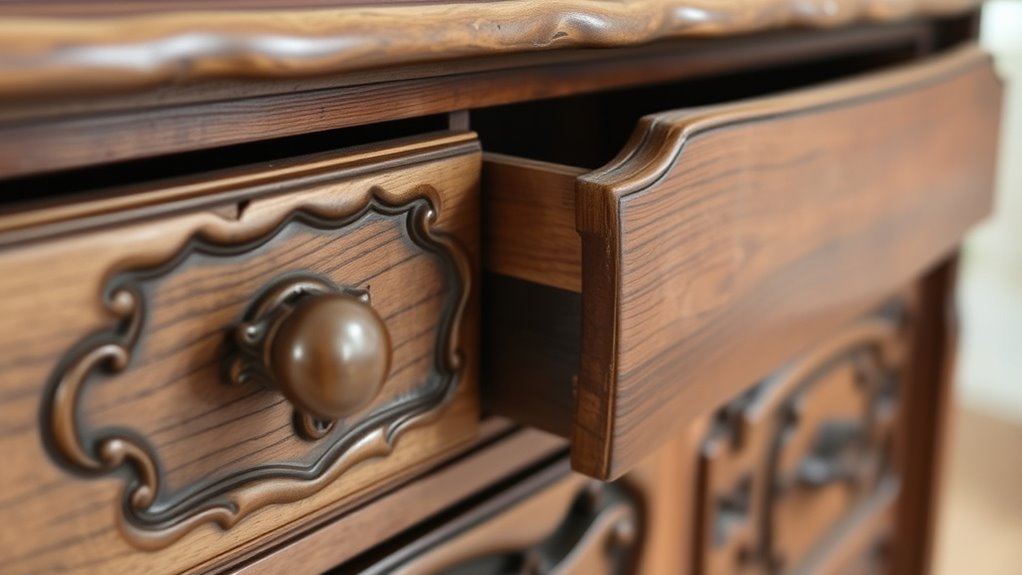
If you notice signs of structural damage or suspect complex finishes, it’s time to call in an expert. Professionals can accurately assess the condition and guarantee proper restoration without causing further harm. Trusting a specialist helps preserve your antique’s value and integrity.
Signs of Structural Damage
How can you tell if your antique furniture has sustained structural damage? Start by checking for loose joints, which can cause wobbling or instability. If parts shift or don’t align properly, it indicates weakened connections. Look for signs of woodworm damage, such as tiny holes or frass (wood dust), which compromise the integrity of the wood. Cracks or splits in the frame also signal deeper issues that might worsen over time. Heavy or uneven sagging, especially in tabletops or legs, suggests structural weakening. If you notice any of these signs, it’s time to consult a professional. Addressing structural damage early can prevent further deterioration and preserve your antique’s value and stability. Don’t ignore these warning signs—expert help ensures proper assessment and repair. Regular inspections and understanding air quality can also help maintain the overall condition of your furniture environment.
Expertise for Complex Finishes
When your antique furniture features intricate or highly decorative finishes, it’s best to bring in a professional for preservation and repair. Complex finishes often involve delicate finishing techniques and detailed decorative motifs that require specialized skills. Attempting repairs yourself could damage the original artistry or diminish value. An expert can accurately identify the type of finish and apply appropriate methods, ensuring authenticity remains intact. They also understand how to handle layered finishes or finishes with gold leaf, paint, or intricate marquetry. Consulting a professional helps preserve the piece’s historical integrity and aesthetic appeal.
- Evaluating delicate finishing techniques
- Restoring decorative motifs accurately
- Handling layered or gilded finishes
- Ensuring authenticity and value
Frequently Asked Questions
How Do I Identify Authentic Antique Furniture?
To identify authentic antique furniture, you should examine its antique provenance and look for authentic markings. Provenance includes the piece’s history and origin, which can often be verified through documentation or expert appraisal. Authentic markings such as maker’s marks, stamps, or labels provide clues to its age and craftsmanship. You actively inspect joints, hardware, and wood aging, ensuring these features align with the period. Trust your eye and research to confirm its true age and origin.
What Are Common Signs of Previous Poor Restorations?
You should watch for signs of previous poor restorations, like uneven paint, mismatched patches, or overly shiny surfaces, as these reveal restoration pitfalls. Refinishing myths often lead to over-sanding or removing original features, which can damage the piece. If you notice thick layers of paint or inconsistent woodwork, it’s a clue that the restoration wasn’t done correctly. Recognizing these signs helps you decide whether to restore carefully or avoid further damage.
How Can I Determine the Original Finish of My Piece?
To determine the original finish of your piece, focus on finish identification by examining the surface closely for clues like brush marks, cracks, or color variations. Use a small, inconspicuous area to test for finish type. Avoid restoration pitfalls by not stripping or over-sanding, which can damage the original finish. Consulting a professional can help ensure you preserve the authenticity and value of your furniture while making informed decisions.
Are There Eco-Friendly Options for Refinishing Antiques?
This question is as important as the crown jewel of eco-conscious choices! For eco-friendly finishes, you can select water-based or plant-based products, which are gentler on the environment. Sustainable restoration methods focus on using non-toxic, biodegradable materials that preserve your antique’s beauty without harming nature. These options are not only better for the planet but also guarantee your piece stays stunning for generations to come.
What Are the Legal Considerations for Restoring Historically Significant Furniture?
When restoring historically significant furniture, you need to understand your restoration rights and legal preservation requirements. Laws may restrict altering original features or using certain materials to maintain authenticity. You should consult local regulations and preservation agencies to guarantee your work complies with legal standards. By respecting these guidelines, you protect the furniture’s historical value and avoid legal issues, ensuring your restoration preserves the piece’s integrity and significance.
Conclusion
Ultimately, choosing between restoring and refinishing your antique piece depends on its value and sentimental worth. Restoring can bring back its original beauty, but risks losing its authenticity. Refinishing may offer a fresh look, yet can diminish its history. You hold the power to preserve its story or give it new life—just remember, sometimes, embracing its imperfections is what makes it truly special. Trust your heart as much as your judgment.
